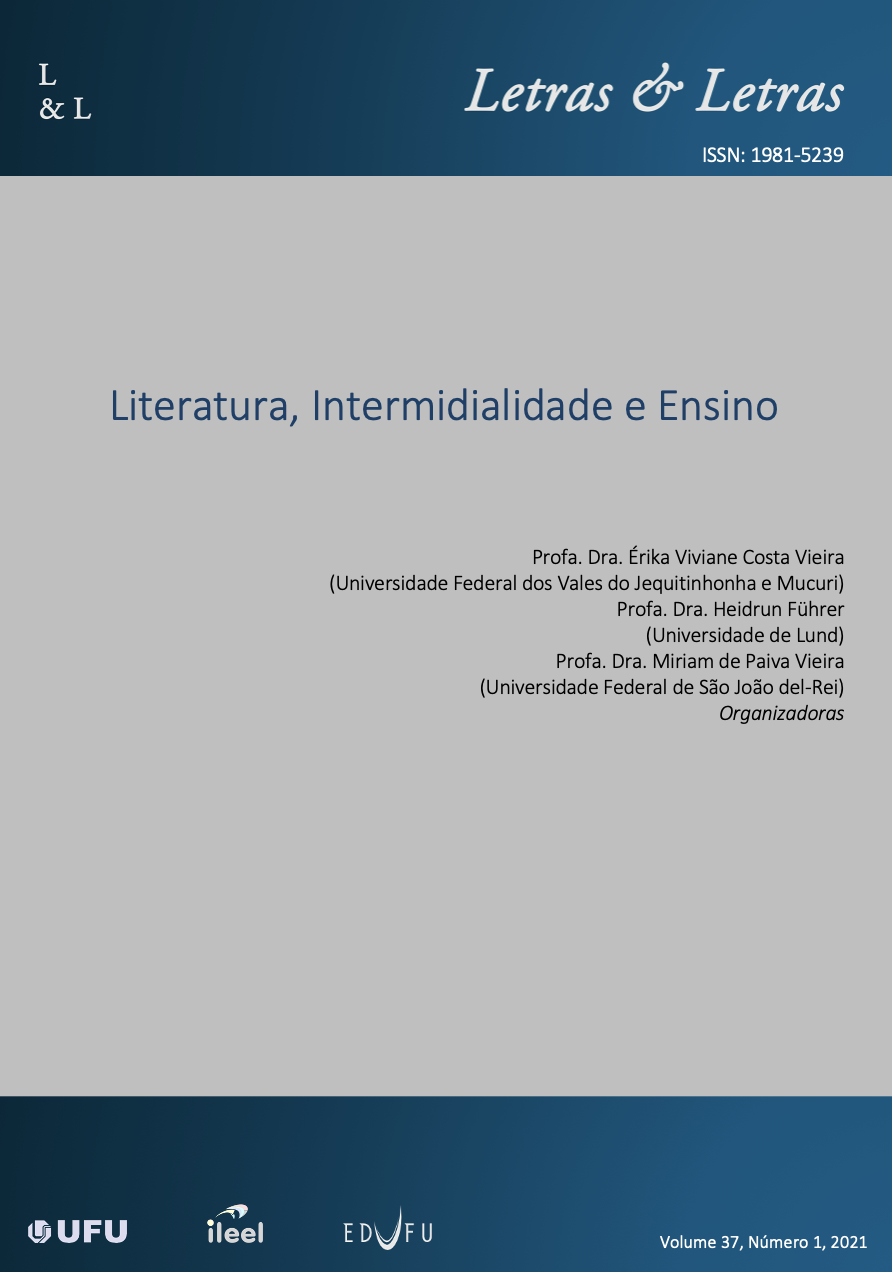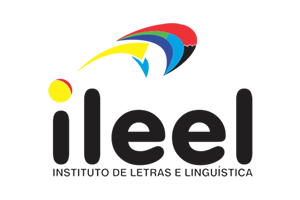Intermidialidade, Textos Narrativos e Tarefas Mediadas Digitalmente na Sala de Aula de Inglês como Língua Estrangeira
DOI:
https://doi.org/10.14393/LL63-v37n1-2021-05Palavras-chave:
Ensino de inglês como língua estrangeira, Ensino de língua baseado em tarefas, Mídia digital, Cultura participativa, Textos narrativosResumo
Em nosso artigo, propomos que intermidialidade e cultura participativa são conceitos entrelaçados que fazem parte do mundo digital. Usando o ensino de línguas baseado em tarefas (TBLT) como uma estrutura pedagógica, argumentamos que as tarefas digitalmente mediadas podem ser benéficas para a sala de aula de inglês e, ao mesmo tempo, incluir aspectos de intermidialidade e cultura participativa. Na última parte do artigo, apresentamos exemplos de tarefas que abordam esse problema e testadas em sala de aula de inglês como língua estrangeira.
Downloads
Referências
BIEBIGHÄUSER, K.; ZIBELIUS, M.; SCHMIDT, T. Aufgaben 2.0 – Aufgabenorientierung beim Fremdsprachenlernen mit Digitalen Medien. In: BIEBIGHÄUSER, K.; ZIBELIUS, M.; SCHMIDT, T. (Ed.). Aufgaben 2.0 – Konzepte, Materialien und Methoden für das Fremdsprachen-Lehren und -Lernen mit digitalen Medien. Tübingen: Narr, 2012. p. 11-56.
BREDELLA, L. Lesen und Interpretieren im ‚Gemeinsamen europäischen Refe¬renzrahmen für Sprachen‘: Die Missachtung allgemeiner Erziehungsziele. In: BAUSCH K.-R. et al. (Ed.). Der Gemeinsame europäische Referenzrahmen für Sprachen in der Diskussion. Arbeitspapiere der 22. Frühjahrskonferenz zur Erforschung des Fremdsprachenunterrichts. Tübingen: Narr, 2003. p. 45-56.
BREDELLA, L. Die welterzeugende und welterschließende Kraft literarischer Texte. In: BREDELLA, L.; HALLET, W. (Ed.). Literaturunterricht, Kompetenzen und Bildung. Trier: WVT, 2007. p. 65-86.
BYRAM, M. Teaching and assessing intercultural communicative competence. Clevedon: Multilingual Matters, 1997.
CARUSO, C.; HOFMANN, J. A task-based approach to tablets and apps in the foreign language classroom. Currents in Teaching and Learning, v. 10 n. 2, p. 68-77, 2018.
DAUSEND, H.; NICKEL, S. Tap’n’Talk – Differenzierte Förderung von Sprachproduktionen durch tabletgestützte Lernaufgaben. In: CHILLA, S.; VOGT, K. (Ed.), Heterogenität und Diversität im Englischunterricht. Fachdidaktische Perspektiven. Frankfurt am Main: Peter Lang, 2017. p. 179-203.
ELLIS, R. Task-based language learning and teaching. Oxford: Oxford University Press, 2003.
FOUCAULT, M. The Confession of the Flesh. In: GORDON, C. (Ed.). Power/Knowledge. Selected interviews and other writings 1972-1977. New York: Pantheon, 1980. p. 194-228.
GIBBONS, P. Scaffolding language, scaffolding learning. Teaching second language learners in the mainstream classroom. Portsmouth, NH: Heinemann, 2002.
GONZÁLEZ-LLORET, M.; ORTEGA, L. Towards technology-mediated TBLT: An introduction. In: GONZÁLEZ-LLORET, M.; ORTEGA, L. (Ed.) Task-based language teaching. Amsterdam: John Benjamins, 2014. p. 1-22. DOI: https://doi.org/10.1075/tblt.6.01gon
GRAU, M. Worlds Apart? English in German youth cultures and in educational settings. World Englishes v. 28 n. 2, 160-174, 2009. DOI: https://doi.org/10.1111/j.1467-971X.2009.01581.x
HALLET, W. (How) can we close the gap? Zum Verhältnis von Literatur, Kulturwissenschaften und Didaktik am Beispiel der Intertextualität und Nick Hornbys Roman High Fidelity. In: BREDELLA, L.; DELANOY, W.; SURKAMP, C. (Ed.). Literaturdidaktik im Dialog. Tübingen: Narr, 2004. p. 207-238.
HALLET, W. Semiotic translation, literacy learning and teacher development. In: CLIL ACROSS CONTEXTS: A SCAFFOLDING FRAMEWORK FOR CLIL TEACHER EDUCATION, 23-25 April 2009, Université de Luxembourg. Proceedings... Luxemburg: Université de Luxembourg, 2009. p. 1-3. Available at: https://languagelearninglog.de/wp-content/uploads/2018/02/180218_2009_HALLET_Semiotic_Translation_Teacher_Education.pdf. Access on: June 30, 2021.
HALLET, W. Reading Multimodal Fiction. Anglistik, v. 29, n. 1, p. 25-40, 2018.
JENKINS, H. Textual poachers. Television fans and participatory culture. New York: Routledge, 1992.
JENKINS, H. Transmedia storytelling. MIT Technology Review, n.p., 2003. Available at: https://www.technologyreview.com/s/401760/transmedia-storytelling/. Access on: June 30, 2021.
JENKINS, H.; PURUSHOTMA, R.; WEIGEL, M.; CLINTON, C.; ROBINSON, A. J. Confronting the challenges of participatory culture: Media education for the 21st century. The John D. and Catherine T. MacArthur Foundation reports on digital media and learning. Cambridge, MA: The MIT Press, 2009. DOI: https://doi.org/10.7551/mitpress/8435.001.0001
KULTUSMINISTERKONFERENZ. Bildungsstandards für die erste Fremdsprache (Englisch/Französisch) für den mittleren Schulabschluss. München: Luchterhand, 2003.
KULTUSMINISTERKONFERENZ. Bildungsstandards für die fortgeführte Fremdsprache (Englisch / Französisch) für die Allgemeine Hochschulreife. 2012. Available at http://www.kmk.org/fileadmin/veroeffentlichungen_beschluesse/2012/2012_10_18-Bildungsstandards-Fortgef-FS-Abi.pdf. Access on: June 30, 2021.
MAIWALD, K. Intermedialität. Zur Einführung in das Thema. In: MAIWALD, K. (Ed.). Intermedialität. Formen – Diskurse – Didaktik. Baltmannsweiler: Schneider Verlag Hohengehren, 2019. p. 1-22.
NUNAN, D. Task-based language teaching. Cambridge, UK: Cambridge University Press, 2004. DOI: https://doi.org/10.1017/CBO9780511667336
NÜNNING, A.; SURKAMP, C. Englische Literatur unterrichten. Grundlagen und Methoden. Seelze-Velber: Klett/Kallmeyer, 2006.
O’BRIEN, D.; SCHARBER, C. Digital literacies. Journal of Adolescent and Adult Literacy, v. 52, n. 1, p. 66-68, 2008. DOI: https://doi.org/10.1598/JAAL.52.1.7
RAJEWSKY, I. O. Intermediality, intertextuality, and remediation: A literary perspective on intermediality. Intermédialités / Intermediality, n. 6, p. 43-64, 2005. DOI: https://doi.org/10.7202/ 1005505ar
RIPPL, G. Film and Media Studies. In: MIDDEKE, M.; MÜLLER, T.; WALD, C.; ZAPF, H. (Ed.). English and American studies. Theory and practice. Stuttgart: Metzler, 2012. p. 314-323.
RYAN, M.-L. Media and narrative. In: HERMAN, D.; JAHN, M.; RYAN, M.-L. (Ed.). The Routledge encyclopedia of narrative theory. London: Routledge, 2005. p. 288-292.
SCHMIDT, T.; STRASSER, T. Digital classroom. Der Fremdsprachliche Unterricht Englisch, v. 144, p. 2-7, 2016.
VAN DEN BRANDEN, K. Introduction: Task-based language teaching in a nutshell. In: VAN DEN BRANDEN, K. (Ed.). Task-based language education. Cambridge: Cambridge University Press, 2006. p. 1-16. DOI: https://doi.org/10.1017/CBO9780511667282.002
WOLF, W. The relevance of mediality and intermediality to Academic Studies of English Literature. SPELL: Swiss Papers in English Language and Literature, n. 21, p. 15-43, 2008. DOI: https://doi.org/10.5169/seals-130648
WOLF, W. Das Feld der Intermedialität im Überblick. In: MAIWALD, K. (Ed.). Intermedialität. Formen – Diskurse – Didaktik. Baltmannsweiler: Schneider Verlag Hohengehren, 2019. p. 23-48.
Downloads
Publicado
Edição
Seção
Licença
Autores que publicam nesta revista concordam com os seguintes termos:
Autores mantêm os direitos autorais e concedem à revista o direito de primeira publicação, com o trabalho simultaneamente licenciado sob a Creative Commons Attribution License que permitindo o compartilhamento do trabalho com reconhecimento da autoria do trabalho e publicação inicial nesta revista.
Autores têm autorização para assumir contratos adicionais separadamente, para distribuição não-exclusiva da versão do trabalho publicada nesta revista (ex.: publicar em repositório institucional ou como capítulo de livro), com reconhecimento de autoria e publicação inicial nesta revista.










